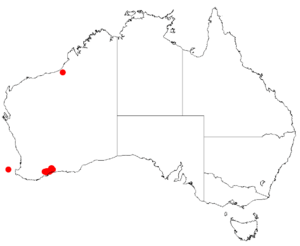Acacia bifaria facts for kids
Quick facts for kids Acacia bifaria |
|
|---|---|
| Conservation status | |
| Scientific classification | |
| Genus: |
Acacia
|
| Species: |
bifaria
|
 |
|
| Occurrence data from AVH | |
The Acacia bifaria is a special type of shrub. It belongs to the large plant group called Acacia. You can find this plant growing naturally along the southern coast of Western Australia.
About Acacia bifaria
This shrub often grows low to the ground. It can spread out like a dome. It usually reaches a height of about 0.3 to 0.8 meters (1 to 2.6 feet). It can also spread wide, up to 2 meters (6.6 feet) across.
What it Looks Like
The branches of Acacia bifaria are smooth and can be a bit wavy. They have small, lasting leaf-like parts called stipules. The leaves, called phyllodes, are always green. They connect to the branches and form opposite wings. Each phyllode is about 1 to 3.5 centimeters (0.4 to 1.4 inches) long. They are also 4 to 10 millimeters (0.16 to 0.4 inches) wide.
This plant produces round, yellow flowers. These flowers appear between August and December. Each flower cluster has about 16 to 23 light golden flowers. After the flowers, black seed pods grow. These pods are very curved, sometimes even coiled twice. They are about 2 centimeters (0.8 inches) long. The pods are also 2 to 3 millimeters (0.08 to 0.12 inches) wide. Inside, they hold oblong-shaped seeds.
How it Got its Name
A botanist named Bruce Maslin first officially described this plant. He did this in 1995. His work was part of a study on Acacia plants from Western Australia. This study was published in a science journal called Nuytsia.
Later, in 2003, another botanist named Leslie Pedley reclassified the species. He moved it to a different group called Racosperma bifarium. But in 2006, it was moved back to the Acacia group. So, its official name is still Acacia bifaria.
Where it Grows
Acacia bifaria grows in areas with mallee trees and woodlands. It has a small natural range. You can find it along the south coast of Western Australia. This includes areas near Jerramungup and Ravensthorpe. It often grows in clay, rocky loam, or sandy soils. You might see it on flat plains, in low-lying spots, or even along roadsides.


